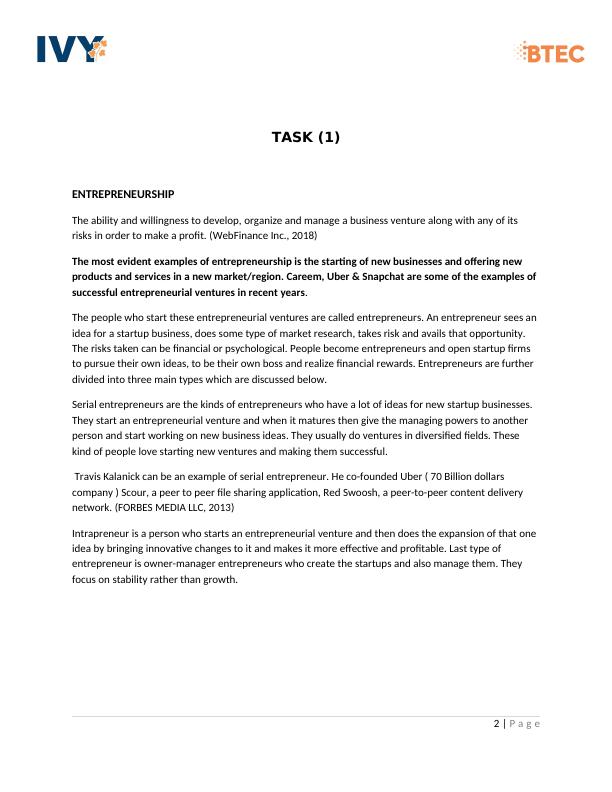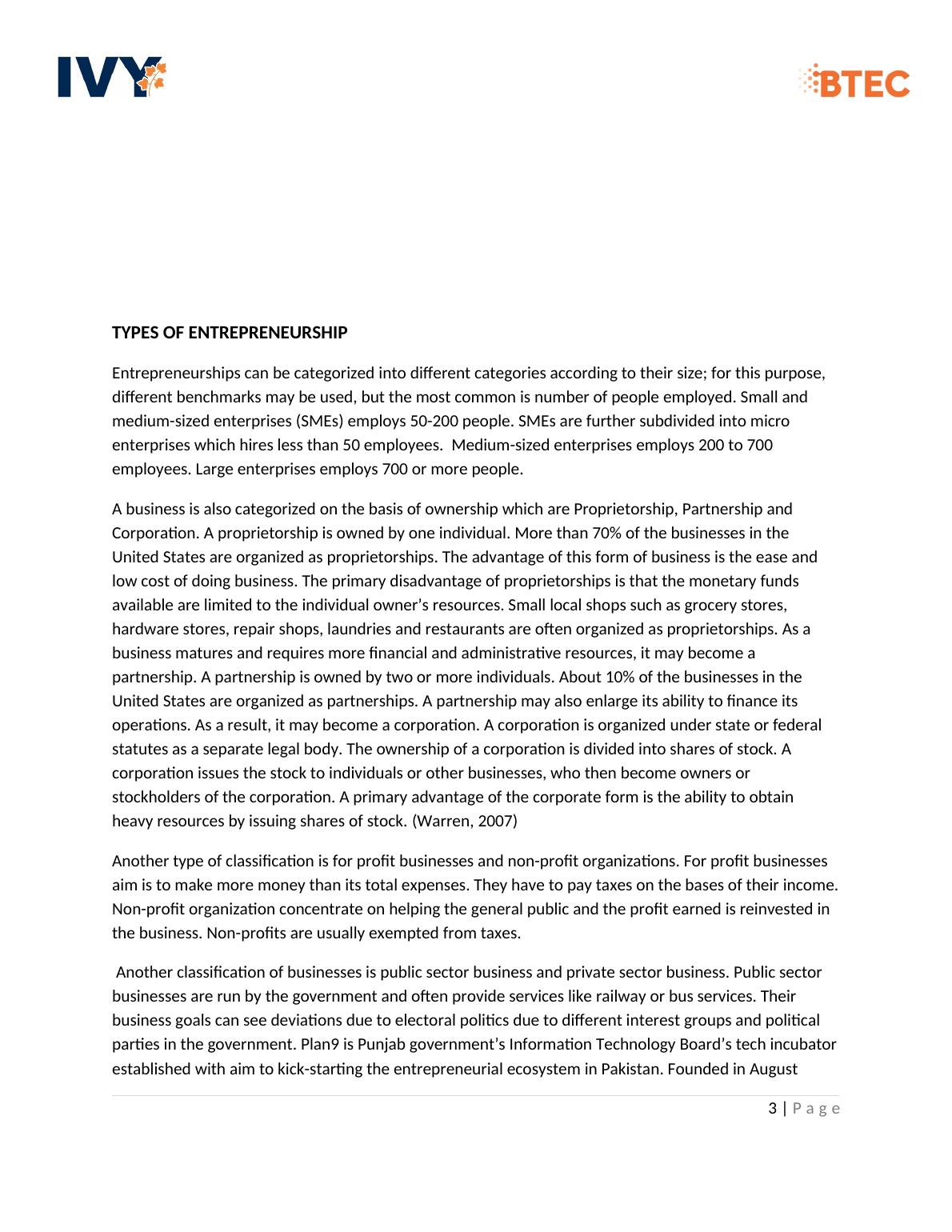Entrepreneurship & Small in Business
Added on 2021-06-01
12 Pages4937 Words81 Views
ASSESSMENT SUBMISSION & DECLARATIONQUALIFICATIONUNITNUMBERANDTITLEPEARSON BTEC HIGHER NATIONAL DIPLOMAIN BUSINESS (RQF)09. ENTREPRENEURSHIP & SMALL BUSINESS MANAGEMENT (LEVEL 4)STUDENTNAME MUHAMMAD BILAL MAJEEDASSESSORNAME SIR AQEELDATEISSUEDCOMPLETIONDATESUBMITTEDON21ST DECEMBER, 2018ASSIGNMENT TITLETHE FIRST OF ITS KIND ENTREPRENEURIAL VENTUREASSESSMENT CRITERIATASK NUMBEREVIDENCE PAGE NUMBERPASS 1TASK 1 PAGE 1 TO 7PASS 2TASK 1 PAGE 1 TO 7PASS 3TASK 3 PAGE 10 TO 11PASS 4TASK 3 PAGE 10 TO 11PASS 5TASK 2 PAGE 8 TO 10PASS 6TASK 2 PAGE 8 TO 10PASS 7TASK 2 PAGE 8 TO 10MERIT 1TASK 1 PAGE 1 TO 7MERIT 2TASK 3 PAGE 10 TO 11MERIT 3TASK 2 PAGE 8 TO 10MERIT 4TASK 2 PAGE 8 TO 10DISTINCTION 1TASK 1 PAGE 1 TO 7DISTINCTION 2TASK 3 PAGE 10 TO 11DISTINCTION 3TASK 2 PAGE 8 TO 10DISTINCTION 4TASK 2 PAGE 8 TO 10PLAGIARISMPlagiarism is a particular form of cheating. Plagiarism must be avoided at all costs and students who break the rules, howeverinnocently, may be penalised. It is your responsibility to ensure that you understand correct referencing practices. As auniversity level student, you are expected to use appropriate references throughout and keep carefully detailed notes of allyour sources of materials for material you have used in your work, including any material downloaded from the Internet.LEARNER DECLARATIONI CERTIFYTHATTHEASSIGNMENTSUBMISSIONISENTIRELYMYOWNWORKAND I FULLYUNDERSTANDTHECONSEQUENCESOFPLAGIARISM. IUNDERSTANDTHATMAKINGAFALSEDECLARATIONISAFORMOFMALPRACTICE.STUDENT SIGNATURE: BELAAL.MAJEED1@GMAIL.COMDATE: 21ST DECEMBER, 20181| P a g e

TASK (1)ENTREPRENEURSHIPThe ability and willingness to develop, organize and manage a business venture along with any of its risks in order to make a profit. (WebFinance Inc., 2018)The most evident examples of entrepreneurship is the starting of new businesses and offering new products and services in a new market/region. Careem, Uber & Snapchat are some of the examples of successful entrepreneurial ventures in recent years.The people who start these entrepreneurial ventures are called entrepreneurs. An entrepreneur sees anidea for a startup business, does some type of market research, takes risk and avails that opportunity. The risks taken can be financial or psychological. People become entrepreneurs and open startup firms to pursue their own ideas, to be their own boss and realize financial rewards. Entrepreneurs are further divided into three main types which are discussed below.Serial entrepreneurs are the kinds of entrepreneurs who have a lot of ideas for new startup businesses. They start an entrepreneurial venture and when it matures then give the managing powers to another person and start working on new business ideas. They usually do ventures in diversified fields. These kind of people love starting new ventures and making them successful.Travis Kalanick can be an example of serial entrepreneur. He co-founded Uber ( 70 Billion dollars company ) Scour, a peer to peer file sharing application, Red Swoosh, a peer-to-peer content delivery network. (FORBES MEDIA LLC, 2013)Intrapreneur is a person who starts an entrepreneurial venture and then does the expansion of that one idea by bringing innovative changes to it and makes it more effective and profitable. Last type of entrepreneur is owner-manager entrepreneurs who create the startups and also manage them. They focus on stability rather than growth.2| P a g e

TYPES OF ENTREPRENEURSHIPEntrepreneurships can be categorized into different categories according to their size; for this purpose, different benchmarks may be used, but the most common is number of people employed. Small and medium-sized enterprises (SMEs) employs 50-200 people. SMEs are further subdivided into micro enterprises which hires less than 50 employees. Medium-sized enterprises employs 200 to 700 employees. Large enterprises employs 700 or more people.A business is also categorized on the basis of ownership which are Proprietorship, Partnership and Corporation. A proprietorship is owned by one individual. More than 70% of the businesses in the United States are organized as proprietorships. The advantage of this form of business is the ease and low cost of doing business. The primary disadvantage of proprietorships is that the monetary funds available are limited to the individual owner’s resources. Small local shops such as grocery stores, hardware stores, repair shops, laundries and restaurants are often organized as proprietorships. As a business matures and requires more financial and administrative resources, it may become a partnership. A partnership is owned by two or more individuals. About 10% of the businesses in the United States are organized as partnerships. A partnership may also enlarge its ability to finance its operations. As a result, it may become a corporation. A corporation is organized under state or federal statutes as a separate legal body. The ownership of a corporation is divided into shares of stock. A corporation issues the stock to individuals or other businesses, who then become owners or stockholders of the corporation. A primary advantage of the corporate form is the ability to obtain heavy resources by issuing shares of stock. (Warren, 2007)Another type of classification is for profit businesses and non-profit organizations. For profit businesses aim is to make more money than its total expenses. They have to pay taxes on the bases of their income.Non-profit organization concentrate on helping the general public and the profit earned is reinvested in the business. Non-profits are usually exempted from taxes.Another classification of businesses is public sector business and private sector business. Public sector businesses are run by the government and often provide services like railway or bus services. Their business goals can see deviations due to electoral politics due to different interest groups and political parties in the government. Plan9 is Punjab government’s Information Technology Board’s tech incubatorestablished with aim to kick-starting the entrepreneurial ecosystem in Pakistan. Founded in August 3| P a g e

2012, the pioneer of incubation in Pakistan is striving every day to mentor new, tech-product based startups of Pakistan. (PITB, 2018)Pakistan international airlines (PIA) is also an example of government owned enterprise. In 2000’s despite being the largest operative on Pakistan’s international and domestic routes, the carrier is increasingly losing its market share due to the mismanagement, corruption and nepotism. PIA has become a “White Elephant” as its operating costs are much higher than its revenues. The private sector business is run by individuals and companies with an aim of making profit. Lyft, Airbnb and Uber are some examples of private sector entrepreneurship. Their business objective is to capture market share and become market leader eventually. Hence they focus their resources on achieving them unlike public sector where there are a lot of bureaucratic hindrances.There are some complexities which occur in different business structures which create problems for a company to get things done efficiently. A large scale company usually has a hierarchical structure divided into departments with each department having a head manager leading that department which reports to senior executives in the company. Complexities arise because each department almost works autonomously which results in communication barriers. Small and medium sized enterprises usually have “Organic structures” also known as “flat" structures. Decentralized decision making and loose departmentalization are its main features. It is a less formal structure than hierarchal one. Role duplication and unclear role definition are one of most usual of the problems. It also becomes difficult tohold someone accountable in this type of structure.In the age of information technology where the world has become a global village, businesses have to adapt themselves and take steps to integrate its different business functions to share information to succeed in the market and increase efficiency. Interrelationship between different organizational functions is very much important. Sales projection cannot be met if sales department loses business because the manufacturing department was unaware of an increase in product demand resulting in revenue loss. Also marketing department cannot promote the products efficiently if they aren’t briefed properly about it. Finance department must also coordinate with other departments like marketing department to allocate budget for marketing campaigns.IMPORTANCE OF ENTREPRENEURSHIPEntrepreneurship’s importance was first articulated in 1934 by Joseph Schumpeter. In his book The Theory of Economic Development, Schumpeter argued that entrepreneurs develop new products and technologies that over time make current products and technologies outdated. Schumpeter called this process creative destruction. Because new products and technologies are typically better than those they replace which in result increases consumer demand. (Schumpeter, n.d.)These agents of change bring creativity to what is currently available. The process of creative destruction is not limited to new products and technologies; it can include new pricing 4| P a g e

End of preview
Want to access all the pages? Upload your documents or become a member.
Related Documents
Entrepreneurial Venture & The Entrepreneurial Mindsetlg...
|26
|13832
|130
Marketing essentials - Assignment PDFlg...
|30
|7168
|36
ASSIGNMENT BRIEF QUALIFICATION UNIT NUMBER AND TITLE PEARSON BTEC HIGHER NATIONAL DIPLOMA IN BUSINESS 03. NOV 2021 07 JAN 2022 RESUBMISSION DATE 19 NOV 2021 07 JAN 2022 RESUBMISSION DATE 20 JAN 2022 Rlg...
|38
|8039
|329
Pearson BTEC Higher National Diploma in Business (rqf)04. Leadership & Management in the workplace Assessment Criteria Task Numbelg...
|23
|7530
|160
Leadership & Management : Diploma in Businesslg...
|29
|8524
|28
Applied Marketing - Assessmentlg...
|16
|3843
|144
